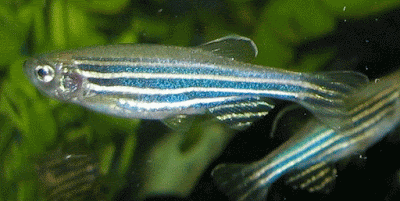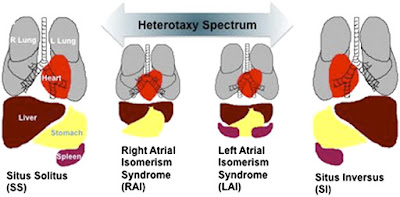Biology concepts – situs inversus, situs ambiguous, dextrocardia, dextroposition, isomerism, canalization
mirror image organs) last week.
Dr. No of the James Bond stories was the quintessential bad guy, but he still had a congenial relationship with 007. During a discussion over tea, or perhaps as Bond hung over a pool of sharks, Dr. No explained to James that he once survived an assassination attempt when a his would be murderer tried to stab him in the heart.
Little did the assassin realize that Dr. No had situs inversus. Even though he was stabbed on the left side, right where his heart should have been, Dr. No laughed it off and then cut up the poor guy with a laser. It helps to have an edge that people don’t know about.
Then again, sometimes situs inversus can be a pain. Donny Osmond, of the Osmond Brothers and then later of Donny and Marie, had situs inversus. As a child he had a bout of lower left abdominal pain. Nothing special is located in the lower left abdomen, so his family ignored it - so did the doctors. When they arrived in England, he had to have emergency surgery because of appendicitis. His situs inversus meant that his appendix was on the opposite side.
In the cases mentioned above, the condition was situs inversus totalis, but it isn’t always totalis. This is rare, but it happens, and most often it involves the heart. Even when it comes to location, the heart wants what the heart wants.
 |
We’re talking about looking for horses instead of zebras and we’re talking about hearts, so why not zebrafish hearts? It turns out that zebra fish can regenerate their heart after injury, as can many animals. A new paper is showing how the cells can change into the cell type they need and then proliferate. |
But zebras do exist, and you have to know that they exist and what they look like. One zebra is called isolated levocardia (levo= left, and cardio = heart). If situs inversus is rare (1in about 10,000 live births), then isolated levocardia is very rare (in about 25,000 live births). Levocardia means that the apex (the bottom of the heart comes to a blunt point) is directed to the left – this is normal. But in isolated levocardia, the rest of the organs are situs inversus, only the heart is in the normal orientation.
Remember that the lungs are designed to fit around the heart. The left lung has a cardiac notch for the apex of the organ. If the lungs are switched, then the cardiac notch is on the right lung; this is fine if the heart is mirrored as well. But in isolated levocardia, the right lung has room for the heart apex, but the heart is point to the left.
The prognosis of patients with isolated levocardia is not good, only 5-13% live beyond the age of five years. This is usually due to severe cardiac defects. The problems with the vessels may be a part of it, but these patients often have defects of the heart organ itself. The chambers may be transposed or the septa between the chambers could have holes or other defects.
Situs inversus with a normal heart position is one exception, but how about the opposite exception? Can all the organs be in the normal orientation except the heart? Yes – it’s called dextrocardia. If you want to be picky, dextrocardia refers to any situation where the apex of the heart points to the right instead of to the left, but the vast majority of these cases occur in situs inversus. What we are talking about is an isolated dextrocardia, although the terms in dextrocardia get somewhat muddled. I prefer dextrocardia without situs inversus or dextrocardia with situs solitus (situs solitus is the normal organ arrangement).
Dextrocardia without situs inversus does occur on its own (sporadic), but it seems that it occurs more rarely in mammals as compared to lower forms (fish, amphibians). This may be an incidence of canalization, the tendency for a conserved trait to become more resistant to mutation or environmentally induced perturbation over evolutionary time.
It’s no wonder heart position is canalized in humans; individuals with dextrocardia without situs inversus also have a very high incidence of severe cardiac malformations and defects. Most patients with isolated levocardia or dextrocardia without situs inversus die before they can reproduce, so any mutations that lead to it are not passed on; therefore most cases are in fact sporadic.
One of the most common congenital heart defects seen in dextrocardia with situs solitus is called transposition of the great arteries. There are five great vessels that carry blood to and from the heart. The superior (1) and inferior (2) vena cava bring blood from the body back to the heart. The pulmonary artery (3) is an exception, being one of the few arteries that carries deoxygenated blood, takes the blood from the right ventricle to the lungs to pick up oxygen. Soon after the pulmonary artery (PA) leaves the heart, it splits in two, one for each lung.
The pulmonary veins (4) bring blood back to the heart from the lungs. Yet another exception – it’s a vein but it carries oxygenated blood. There are actually four pulmonary veins, two from each lung, but they all join together as the get to the left atrium of the heart.
Finally there is the aorta (5). This vessel carries oxygenated blood from the left ventricle to the entire body. This is why the left ventricle has to be so thick and strong. It has a long way to pump the blood. Of course, our descriptions above are of the way the vessels are supposed to fit together.
In transposition of the great arteries (TGA), the aorta and the pulmonary artery have switched connections. The aorta is attached to the right ventricle instead of the left, and the reverse is true for the pulmonary artery. Do you see the problem? In TGA, the aorta receives deoxygenated blood from the SVC and IVC via the right atrium and pumps it right back out to the body. The pulmonary artery receives oxygenated blood from the PVs via the left atrium and pumps it right back to the lungs!
There are in fact two small circulatory systems in TGA: 1) heart – lungs – heart, and 2) body – heart – body. This isn’t a recipe for long-term survival. The only blessing is that we can often see another heart defect in these babies, a patent ductus arteriosus. In utero, a fetus doesn’t need to breathe air, the oxygen for the blood is supplied by mom via the umbilical artery. There is a connection between the pulmonary artery and the aorta called the ductus arteriosus. The blood can travel from the aorta to the pulmonary artery or vice versa through the ductus depending on which side of the heart just contracted.
Usually the ductus arteriosus closes on its own a couple days after birth. In the rare case, the ductus will remain open (patent). These are some of the babies you hear about with a “hole in their heart” (the hole could also be from a patent septal defect). The PDA is the only thing that keeps TGA babies alive – some oxygenated blood from the heart – lung – heart system can mix with the deoxygenated blood of the body – heart – body system.
Patent ductus arteriosus is more common in babies with other congenital heart defects, but doctors often give the infants prostaglandins to ensure that the ductus will stay open until they can get in there and switch the vessel connections surgically. The key is to find out there is a problem before the baby is born.
 |
The two middle images show situs ambiguous. The heart is in the center and has defects, the liver is all across the abdomen, and the spleen is absent in one and too numerous in the other. |
As with all sciences, terminology is important, and there is a discussion now as to whether isomerism or even heterotaxy are appropriate terms to uses for situs ambiguous (reviewed here and here). Isomerism (iso = same and mer = part) means that parts are duplicated, like two right halves of the heart, but it isn’t all the organs or even the whole heart, just the atria. So is this an appropriate term?
Right isomerism usually comes with more heart defects than left isomerism, and there is no spleen in right isomerism as opposed to several spleens in left isomerism. So if I had to have one or the other, I would pick left isomerism for my heterotaxy. There are also malrotation problems in the intestines and the stomach is sometimes on the wrong side. If you’re ever given the choice, just take situs solitus; it’s boring, but it’s safe.
Next week - how similar are twins? Sometimes they are so similar because they didn't completely separate.
For more information or classroom activities, see:
Situs inversus –
situs ambiguous –
transposition of the great vessel



